Social Welfare
Empowering India's Amrit-Peedhi
Posted On: 03 JUN 2025 11:21AM
“It is the government’s resolve to fulfill all the dreams of the Amrit Generation, create countless opportunities, and remove all obstacles in their paths.”
~Prime Minister Shri Narendra Modi
Introduction
In the last eleven years, the Government of India has worked with full dedication to empower the youth. India has the largest youth population in the world, with about 65% of its people under the age of 35. The government regards this as a pivotal opportunity to accelerate the nation’s development and achieve long-term strategic growth. The aim is to help the youth grow, achieve their goals and lead India into the future. The government is making sure that young Indians get access to quality education, modern skills, good jobs and require support to become successful entrepreneurs.
Education: Building a Knowledge Superpower
Over the last decade, India has made rapid progress in strengthening its education system, from schools to universities. Major reforms and expansion of institutions like IITs, IIMs, and AIIMS show the government's strong commitment to providing quality and future-ready education for all.
- National Education Policy (NEP) 2020: Announced on 29.07.2020 the National Education Policy 2020 proposes various reforms in school education as well as higher education including technical education. It aims to increase the GER (Gross Enrolment Ratio) to 100% in preschool to secondary level by 2030 whereas GER in Higher Education including vocational education from 26.3% (2018) to 50% by 2035.

- Higher Education Institutions: According to AISHE portal the number of Higher Education Institutions (HEIs) witnesses a remarkable 13.8% increase, rising from 51,534 in 2014-15 to an impressive 70,683 as of May 2025. This number contains Universities, Colleges, Standalone Universities/Colleges, PM Vidyalaxmi and Research and Development Institutes.
- University Growth: Universities grew from 760 in 2014-15 to 1,334 as of May 2025 showcasing India’s commitment to world-class institutions.
- College Growth: Colleges increased from 38,498 in 2014-15 to 51, 959 as of May 2025 meeting the growing demand for higher education.
- IITs Growth: In 2014, there were 16 Indian Institutes of Technology (IITs). With the addition of 7 new IITs in the subsequent years, the total number has risen to 23 as of May 2025.
IIT Infrastructure Boost: On May 7 2025 cabinet approved Phase-B expansion for 5 IITs (Tirupati, Palakkad, Bhilai, Jammu, Dharwad). Also, ₹11,828.79 crore were sanctioned for infrastructure from 2025–2029. On completion of construction, these five IITs shall be able to cater 13,687 students as against current student strength of 7,111 i.e. an increase of 6,576 students.
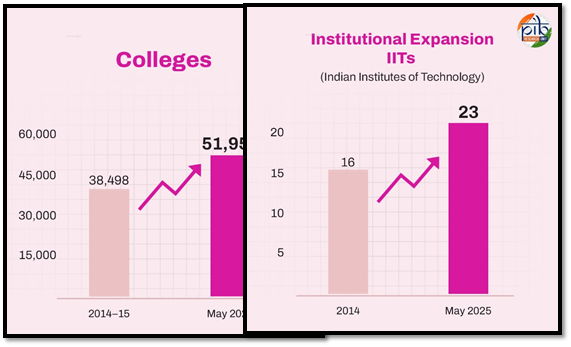
- IIM: In 2014, there were 13 Indian Institutes of Management (IIMs). By May 2025, this number has grown to 21.
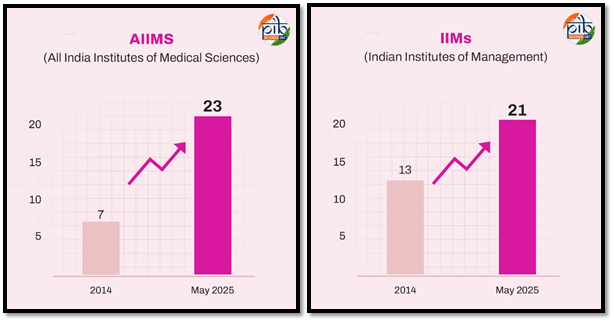
Medical Education Boost: Since 2014, the number of AIIMS institutions has increased from 7 to 23, effectively tripling. Additionally, the number of medical colleges has surged from 387 to 2,045, offering over 1.9 lakh medical seats as of 2024.
- School Development: 14,500 schools to be upgraded under PM SHRI (PM Schools for Rising India) Yojana.
Launched in September 2022, the PM SHRI (PM Schools for Rising India) scheme is a Centrally Sponsored initiative with a total outlay of ₹27,360 crore (₹18,128 crore as central share) for five years (2022–23 to 2026–27). The scheme aims to transform selected schools into model institutions showcasing all components of the National Education Policy 2020. These schools will focus on quality education, holistic development and 21st-century skills, while also serving as mentor institutions for neighboring schools.
Skilling: Preparing for the Jobs of Tomorrow
India has one of the youngest populations in the world. To make the most of this, it is important that the youth are trained in skills that match industry needs. Over the years, major progress has been made. The number of students in their final and pre-final years who are job-ready has gone up from 33.9% in 2014 to 51.3% in 2024.
- PM Kaushal Vikas Yojana (PMKVY: Over 1.63 crore youth trained in diverse skill areas since 2015.
Pradhan Mantri Kaushal Vikas Yojana (PMKVY) was launched in 2015 with the objective to deliver skills to the youth of the country through Short Term Training (STT) and Recognition of Prior Learning (RPL).
- PMKVY 1.0 (2015-16), more than 19 lakh candidates were trained.
- PMKVY 2.0 (2016-20), 1.10 Crore candidates were trained.
- PMKVY 3.0 (2020-21), 7.37 lakh candidates were trained.
- PMKVY 4.0, the current version of the scheme is under implementation from FY 2022-23 onwards.
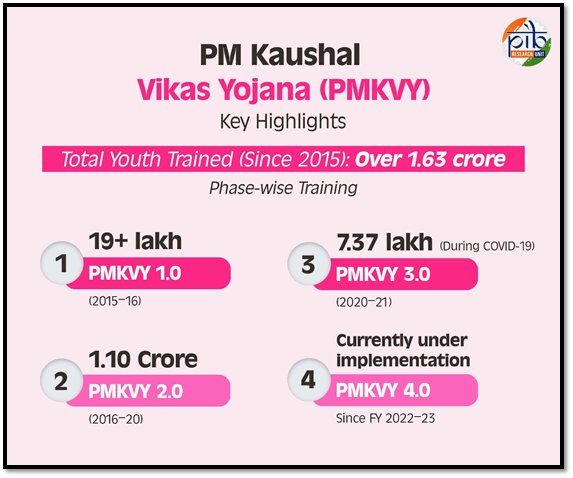
- Sector Skill Councils: The Capital Goods sector is focused on helping workers improve their skills through training, re-training and upgrading their abilities. To support this, the Sector Skill Council has developed 40 Qualification Packs (QPs) designed for higher-level jobs. These QPs are clear guides showing the skills needed for advanced jobs. They help workers get the right training to meet industry standards and secure better jobs.
The National Policy on Skill Development and Entrepreneurship, 2015 launched the Skill India Mission and proposed setting up Sector Skill Councils (SSCs) through the National Skill Development Corporation (NSDC). These councils focus on key sectors identified through skill gap analysis. So far, the NSDC Board has approved 36 SSCs, with over 600 corporate representatives involved in their governing councils, ensuring industry-relevant skill training.
- Advanced Training: Common Engineering Facility Center (CEFC) under Welding Research Institute (WRI) at BHEL Trichy trained 8,143 individuals in welding technologies. The total project cost is Rs. 87.06 Crore out of which sanctioned Ministry of Heavy Industries grant is Rs. 69.648 Crore.
A Common Engineering Facility Center (CEFC) is a shared workspace or hub that provides access to advanced engineering tools, machinery and technology for small and medium enterprises (SMEs), startups and entrepreneurs.
Employment: Building Careers
Creating jobs and expanding employment opportunities have been top priorities for the government. Focused efforts in recruitment, industry growth and exports have helped generate formal jobs across sectors.
- Rozgar Mela: Launched by the Prime Minister on 22nd October 2022, Rozgar Mela is a key step toward boosting employment generation across the country. It aims to empower youth by providing meaningful job opportunities and enhancing their role in national development. So far, 15 national-level Rozgar Melas have been organized, through which approximately 10 lakh appointment letters have been distributed, offering government jobs and boosting employment opportunities across the country.
- EPFO Job Growth: Since 2017, 8.59 crore new subscribers have joined EPFO. Notably, over 3.45 crore youth aged 18–28 have been added since April 2020, indicating increased employment among young workers.
The Employees' Provident Fund Organisation (EPFO) is a government body managing retirement savings for workers in the organized sector. It began with the EPF Ordinance in 1951, later replaced by the EPF Act in 1952.
Entrepreneurship: From Job Seekers to Job Creators
Entrepreneurship is now seen as a key driver of growth and self-reliance among India’s youth. With strong government support, starting a business has become a respected and achievable goal for young Indians.
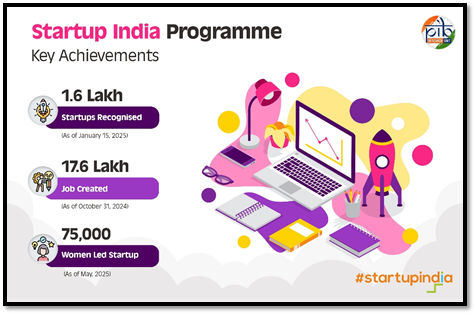
Startup India Programme: Startup India initiative has played a pivotal role in shaping a vibrant entrepreneurial ecosystem in the country. Launched in 2016, it has supported over 1.6 lakh recognized startups, creating more than 17.6 lakh jobs.
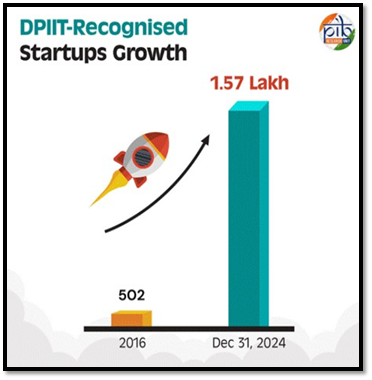
DPIIT Recognized Startups: The Department for Promotion of Industry and Internal Trade (DPIIT) is the nodal agency that implements and monitors the Startup India initiative, providing essential support for startups to thrive in India’s innovation ecosystem.
As a result of this focused support and enabling environment, India has emerged as the third-largest startup ecosystem in the world, with over 1.57 lakh startups recognized by DPIIT as of December 31, 2024. These startups have collectively created over 4.8 lakh direct jobs between 2017 and 2024.
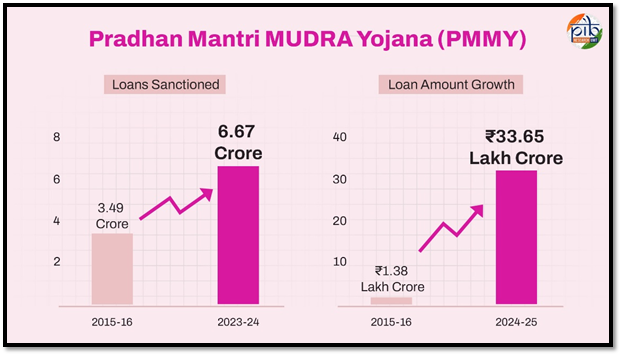
MUDRA Yojana: Launched on 8th April 2015 Pradhan Mantri MUDRA Yojana (PMMY) provides easy credit to millions of small entrepreneurs. On July 23, 2024, the loan limit was increased from ₹10 lakh to ₹20 lakh to further support aspiring entrepreneurs.
The number of loans sanctioned to entrepreneurs has seen remarkable growth over the past decade. In 2015–16, 3.49 crore loans were sanctioned, which rose to 6.67 crore in 2023–24. As of March 21, 2025, the provisional figure for 2024–25 stands at 4.53 crore loans. This surge in entrepreneurial credit is matched by a significant rise in the total loan amount from ₹1.37 lakh crore in 2015–16 to ₹33.65 lakh crore in 2024–25.
Sports: Making India a Sporting Nation
The government has taken major steps to promote sports and support young talent across the country. With better training, facilities and financial aid, India is becoming a strong sporting nation.
- Target Olympic Podium Scheme (TOPS): Under the scheme 94 core group athletes and 112 development group athletes are getting full support for their training and preparation.
Target Olympic Podium Scheme (TOPS) is a flagship initiative of the Ministry of Youth Affairs and Sports, launched in September 2014 to support India’s top athletes in winning Olympic and Paralympic medals. It provides holistic support like training, equipment, international exposure, and a monthly stipend.
- Khelo India Movement: 1,048 centres opened to nurture grassroots talent. 3,000 athletes supported under Khelo India with financial assistance of ₹6.28 lakh per annum.
The 'Khelo India National Programme for Development of Sports' was launched in 2016-17 with the twin objective of mass participation and promotion of excellence in sports across the country. The scheme has been extended from 2021-22 to 2025-26 at financial outlay of Rs. 3790.50 crore.
- National Games 2025: The 38th National Games were held in Uttarakhand from January 28 to February 14, 2025, featuring participation from over 10,000 athletes across India. The Services Sports Control Board topped the medal tally with 68 gold, 26 silver and 27 bronze medals. Maharashtra finished as first runner-up (54 gold, 71 silver, 76 bronze), followed by Haryana as second runner-up (48 gold, 47 silver, 58 bronze). Meghalaya will host the 39th edition in 2026. India continues to strengthen its sporting ecosystem as it aspires to host the 2036 Olympic Games.
- Medal Milestones:
- Tokyo Olympics 2021 and Paris Olympic 2024: India won 7 medals in the Tokyo Olympics 2020. These included 1 Gold, 2 Silver and 4 Bronze medals. In the Paris Olympics 2024, India won 6 medals. These included 1 Silver and 5 Bronze medals.
- Paris Paralympics 2024: India's most successful Paralympic campaign to date unfolded at the 2024 Paris Games, where Indian athletes achieved an extraordinary feat, securing a record-breaking 29 medals.
- Commonwealth Games 2022: Commonwealth Games 2022 held in Birmingham, where India bagged 61 medals (22 Gold, 16 Silver and 23 Bronze) in various disciplines.
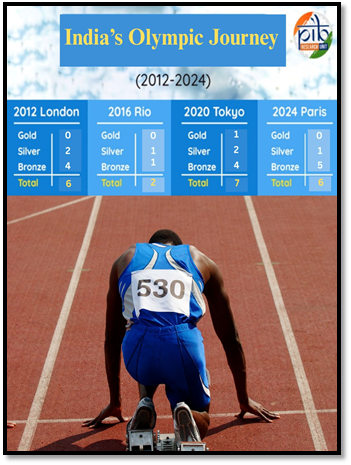
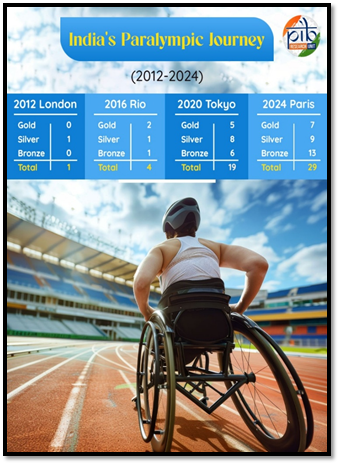
Channeling Youth Energy for the Nation
India is actively engaging its youth in nation-building through initiatives that foster leadership, discipline, and innovation. Programmes like Agnipath and the revamped National Youth Festival are creating new pathways for young Indians to serve, lead, and shape the future.
- Agnipath Scheme: Upto 1.5 lakh Agniveers have been enrolled till Feb 2025 under the scheme.
The Government had launched Agnipath scheme on June 15, 2022 to recruit both male and female aspirants into ‘below the officer’s rank’ cadre of the three services for a period of four years as Agniveers. Candidates between the age group of 17.5 to 21 years are eligible to apply for the scheme.
- National Youth Festival 2025: The Viksit Bharat Young Leaders Dialogue 2025, held on January 11–12 to mark the 162nd birth anniversary of Swami Vivekananda, brought together 3,000 exceptional young leaders from across India. Selected through a rigorous, merit-based process from over 30 lakh participants, the event featured a special interaction with Prime Minister Shri Narendra Modi on January 12. Breaking away from the 25-year-old format of the National Youth Festival, this platform enabled youth to present innovative ideas and actionable solutions for building a developed India.
Conclusion
In the last eleven years, India has focused on empowering its youth. From better education and skills to jobs and business support, many steps have been taken. The government has built more colleges, trained crores under skill schemes, and helped startups grow. Programs like Rozgar Mela, Khelo India, and Agnipath give new chances to the youth. With these efforts, India is turning its young population into a driving force for a strong and developed nation. Empowering the Amrit Peedhi is the path to making India a global leader in the Amrit Kaal.
References
Empowering India's Amrit-Peedhi
****
Explainer 02/Series on 11 Years of Government
Santosh Kumar/ Ritu Kataria/ Kamna Lakaria
(Backgrounder ID: 154537)
Visitor Counter : 1205